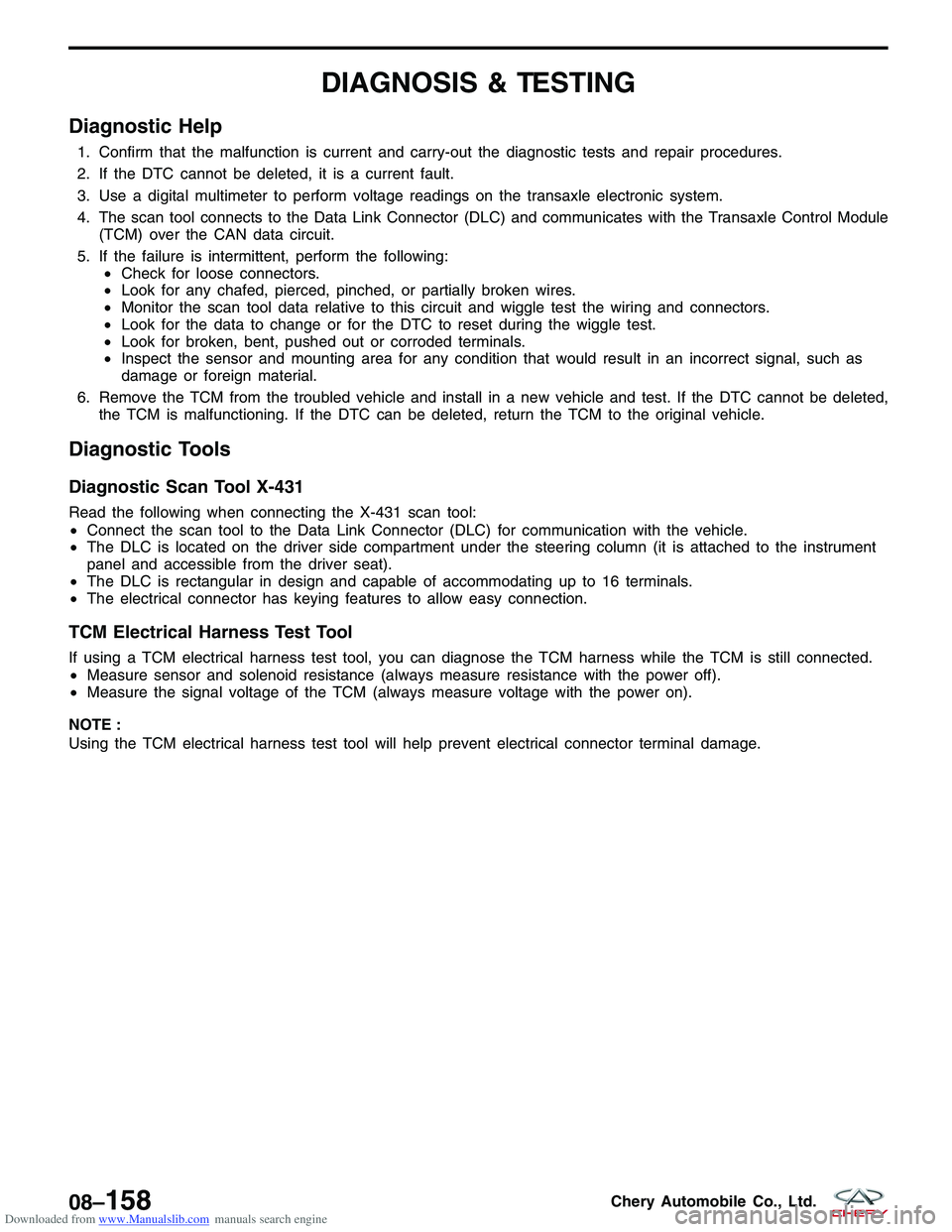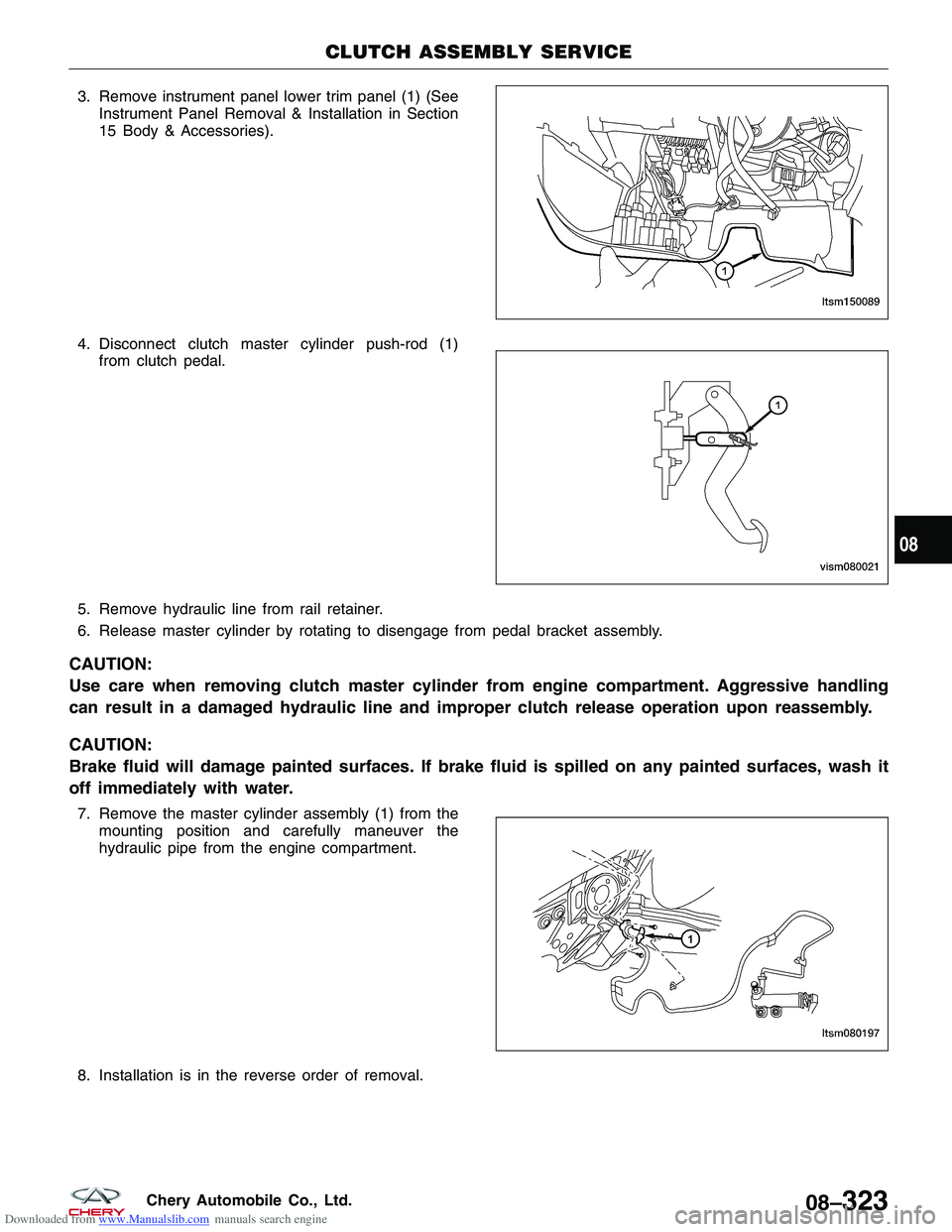Page 724 of 1903

Downloaded from www.Manualslib.com manuals search engine Engine Control Module (ECM)
Description
The Engine Control Module (ECM) for this model is serviced only as a complete unit.
Operation
The ECM is a pre-programmed, microprocessor-based digital computer. It regulates ignition timing, air-fuel ratio,
emission control devices, charging system, certain transmission features, speed control, air conditioning compressor
clutch engagement and idle speed. The ECM can adapt its programming to meet changing operating conditions.
Removal & Installation
1. Disconnect the negative battery cable.
2. Remove the glove box (See Instrument Panel Removal & Installation in Section 15 Body).
3. Disconnect the ECM electrical connector.
4. Remove the ECM retaining bolts (1).(Tighten: ECM retaining bolts to 10 N·m)
5. Remove the ECM.
6. Installation is in the reverse order of removal.
Installation Notes:
•
NOTE :
The Immobilizer control module must be matched to
the new
ECM before the vehicle will start.
Matching Immobilizer Control Module to New
Engine Control Module (ECM)
Perform the following to match the Immobilizer control
module to the new ECM:
� With the X-431 scan tool, choose T11 series.
� Choose �immobilize�.
� Choose �input code�.
� Input the safety code.
� Click the small keyboard.
� Click �OK�.
� Choose �Immobilizer adapt�.
� Choose �read Immobilizer to ECM� immedi-
ately.
� Click �OK�.
g
ON-VEHICLE SERVICE
25
03–440Chery Automobile Co., Ltd.
Page 823 of 1903
Downloaded from www.Manualslib.com manuals search engine Engine Control Module (ECM)
Description
The Engine Control Module (ECM) for this model is serviced only as a complete unit.
Operation
The ECM is a pre-programmed, microprocessor-based digital computer. It regulates ignition timing, air-fuel ratio,
emission control devices, charging system, certain transmission features, speed control, air conditioning compressor
clutch engagement and idle speed. The ECM can adapt its programming to meet changing operating conditions.
Removal & Installation
1. Disconnect the negative battery cable.
2. Remove the glove box (See Instrument Panel Removal & Installation in Section 15 Body & Accessories).
3. Disconnect the ECM connector.
4. Remove the ECM retaining bolts (1).(Tighten: ECM retaining bolts to 10 N·m)
5. Remove the ECM.
6. Installation is in the reverse order of removal.
ON-VEHICLE SERVICE
LTSM030025
03
03–539Chery Automobile Co., Ltd.
Page 1085 of 1903
Downloaded from www.Manualslib.com manuals search engine Transaxle Control Module (TCM)
Removal & Installation
1. Disconnect the negative battery cable.
2. Remove the glove box retaining bolts (1).
3. Disconnect the TCM electrical connectors.
4. Remove the four bolts (1) that mount the TCM tothe instrument panel bracket.
5. Remove the TCM.
6. Installation is in the reverse order of removal.
ON-VEHICLE SERVICE
LTSM150086
LTSM080169
08–142Chery Automobile Co., Ltd.
Page 1101 of 1903

Downloaded from www.Manualslib.com manuals search engine DIAGNOSIS & TESTING
Diagnostic Help
1. Confirm that the malfunction is current and carry-out the diagnostic tests and repair procedures.
2. If the DTC cannot be deleted, it is a current fault.
3. Use a digital multimeter to perform voltage readings on the transaxle electronic system.
4. The scan tool connects to the Data Link Connector (DLC) and communicates with the Transaxle Control Module(TCM) over the CAN data circuit.
5. If the failure is intermittent, perform the following: •Check for loose connectors.
• Look for any chafed, pierced, pinched, or partially broken wires.
• Monitor the scan tool data relative to this circuit and wiggle test the wiring and connectors.
• Look for the data to change or for the DTC to reset during the wiggle test.
• Look for broken, bent, pushed out or corroded terminals.
• Inspect the sensor and mounting area for any condition that would result in an incorrect signal, such as
damage or foreign material.
6. Remove the TCM from the troubled vehicle and install in a new vehicle and test. If the DTC cannot be deleted, the TCM is malfunctioning. If the DTC can be deleted, return the TCM to the original vehicle.
Diagnostic Tools
Diagnostic Scan Tool X-431
Read the following when connecting the X-431 scan tool:
•Connect the scan tool to the Data Link Connector (DLC) for communication with the vehicle.
• The DLC is located on the driver side compartment under the steering column (it is attached to the instrument
panel and accessible from the driver seat).
• The DLC is rectangular in design and capable of accommodating up to 16 terminals.
• The electrical connector has keying features to allow easy connection.
TCM Electrical Harness Test Tool
If using a TCM electrical harness test tool, you can diagnose the TCM harness while the TCM is still connected.
•Measure sensor and solenoid resistance (always measure resistance with the power off).
• Measure the signal voltage of the TCM (always measure voltage with the power on).
NOTE :
Using the TCM electrical harness test tool will help prevent electrical connector terminal damage.
08–158Chery Automobile Co., Ltd.
Page 1266 of 1903

Downloaded from www.Manualslib.com manuals search engine 3. Remove instrument panel lower trim panel (1) (SeeInstrument Panel Removal & Installation in Section
15 Body & Accessories).
4. Disconnect clutch master cylinder push-rod (1) from clutch pedal.
5. Remove hydraulic line from rail retainer.
6. Release master cylinder by rotating to disengage from pedal bracket assembly.
CAUTION:
Use care when removing clutch master cylinder from engine compartment. Aggressive handling
can result in a damaged hydraulic line and improper clutch release operation upon reassembly.
CAUTION:
Brake fluid will damage painted surfaces. If brake fluid is spilled on any painted surfaces, wash it
off immediately with water.
7. Remove the master cylinder assembly (1) from the mounting position and carefully maneuver the
hydraulic pipe from the engine compartment.
8. Installation is in the reverse order of removal.
CLUTCH ASSEMBLY SERVICE
LTSM150089
VISM080021
LTSM080197
08
08–323Chery Automobile Co., Ltd.
Page 1359 of 1903

Downloaded from www.Manualslib.com manuals search engine DIAGNOSIS & TESTING
Power Steering Troubleshooting Chart
Review this troubleshooting chart any time a power steering system problem is present. This chart will help deter-
mine if the power steering pump or power steering gear is functioning properly.
CONDITIONPOSSIBLE CAUSES CORRECTION
Steering Wheel Is Loose · Steering wheel retaining bolt loose.
· Loose steering column to
instrument panel fasteners.· Check steering wheel retaining bolt
torque and tighten to specifications if
necessary.
· Check steering column to
instrument panel fastener torque and
tighten to specifications if necessary.
Steering Catches, Surges Or Sticks
In Certain Positions Or Is Difficult To
Turn · Low power steering fluid level.
· Tire(s) not properly inflated.
· Loose or slipping power steering/
accessory drive belt.
· Lack of lubrication in steering gear
outer tie rod end(s).· Check fluid level and fill to proper
level if necessary. Check for leaks.
Make sure all air is bled from
system.
· Check and inflate tires to the
specified pressure.
· Verify belt tension. Replace belt
auto-tensioner and belt if necessary.
· Check the outer tie rod ends.
Steering Wheel Does Not Return To
Center Position · Tire(s) not properly inflated.
· Improper front wheel alignment.· Check and inflate tires to the
specified pressure.
· Check and adjust wheel alignment
if necessary.
Excessive Steering Wheel Kickback
From Road Inputs · Air in power steering fluid.
· Power steering gear loose on
cradle/sub-frame.
· Steering column, coupling or
intermediate shaft worn or loose.
· Power steering pump flow is too
low.· Inspect for excessive air bubbles in
fluid (fluid will appear foamy and
lighter in color). Inspect hoses for
leaks and replace if necessary.
Bleed air from fluid.
· Inspect gear mounting bolts.
Replace if necessary and tighten to
specifications.
· Rotate steering wheel back-and-
forth while inspecting intermediate
shaft going into steering gear. Look
for excessive free-play. Retighten if
loose bolt is found. Replace steering
column, coupling or intermediate
shaft if necessary.
· Perform power steering flow and
pressure test. Look for low or erratic
flow or pressure. Replace power
steering pump if necessary.
11 –4Chery Automobile Co., Ltd.
Page 1371 of 1903
Downloaded from www.Manualslib.com manuals search engine 9. Disconnect the multi-function switch electrical connector and remove the multi-function switch.
10. Disconnect the wiper and washer switch electrical connector and remove the wiper and washer switch.
11. Remove the spiral cable retaining bolts (1). (Tighten: Spiral cable bolts to 8 N·m)
12. Remove the instrument panel lower shroud bolts (1).
13. Remove the upper mounting bolts (1) from the steering column.
(Tighten: Steering column upper mounting bolts to
25 - 30 N·m)
ON-VEHICLE SERVICE
LTSM110041
LTSM150088 LTSM110020
11 –16Chery Automobile Co., Ltd.
Page 1484 of 1903
Downloaded from www.Manualslib.com manuals search engine GENERAL INFORMATION
Description
This vehicle is equipped with a common HVAC housing assembly. The system combines air conditioning, heating,
and ventilating capabilities in a single unit housing mounted under the instrument panel. The driver can choose the
following functions from HVAC control panel:
•The inside temperature
• The speed of the blower
• Five different modes of operation
• A/C compressor clutch operation
• Recirculation door position
NOTE :
To maintain the performance level of the heating, ventilation and air conditioning (HVAC) system, the engine cooling
system must be properly maintained. Any obstructions in front of the radiator or A/C condenser will reduce the per-
formance of the A/C and engine cooling systems.
13–2Chery Automobile Co., Ltd.